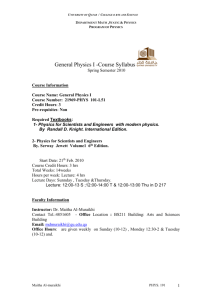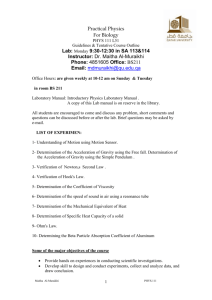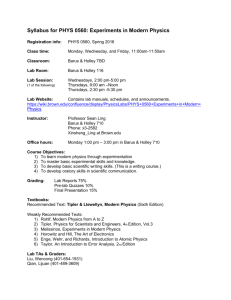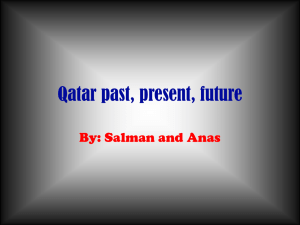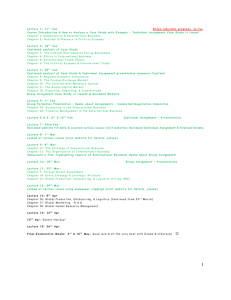DOC - Qatar University
advertisement
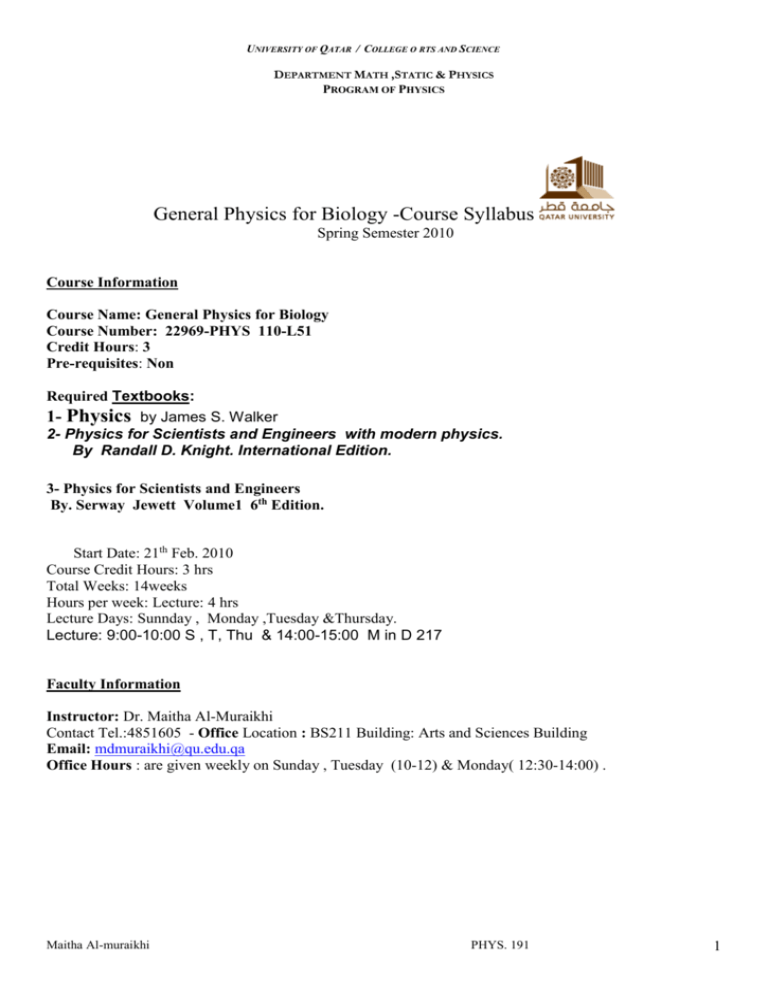
UNIVERSITY OF QATAR / COLLEGE O RTS AND SCIENCE DEPARTMENT MATH ,STATIC & PHYSICS PROGRAM OF PHYSICS General Physics for Biology -Course Syllabus Spring Semester 2010 Course Information Course Name: General Physics for Biology Course Number: 22969-PHYS 110-L51 Credit Hours: 3 Pre-requisites: Non Required Textbooks: 1- Physics by James S. Walker 2- Physics for Scientists and Engineers with modern physics. By Randall D. Knight. International Edition. 3- Physics for Scientists and Engineers By. Serway Jewett Volume1 6th Edition. Start Date: 21th Feb. 2010 Course Credit Hours: 3 hrs Total Weeks: 14weeks Hours per week: Lecture: 4 hrs Lecture Days: Sunnday , Monday ,Tuesday &Thursday. Lecture: 9:00-10:00 S , T, Thu & 14:00-15:00 M in D 217 Faculty Information Instructor: Dr. Maitha Al-Muraikhi Contact Tel.:4851605 - Office Location : BS211 Building: Arts and Sciences Building Email: mdmuraikhi@qu.edu.qa Office Hours : are given weekly on Sunday , Tuesday (10-12) & Monday( 12:30-14:00) . Maitha Al-muraikhi PHYS. 191 1 UNIVERSITY OF QATAR / COLLEGE O RTS AND SCIENCE DEPARTMENT MATH ,STATIC & PHYSICS PROGRAM OF PHYSICS Course Description This course is designed primarily to be appropriate for students planning to major in Nutrition, Pharmacy, and biological and Environmental sciences. It is algebra and trigonometry-based study of some selected topics drawn from classical and modern Physics, with an emphasis on applications to the course targeted specialty areas of. Topics studied include Classical description of motion in terms of force and energy, States of matter, Elasticity and elastic modulus, Basic of Fluid mechanics, Thermal properties of matter, Electrostatics , Electrodynamics , Elements of Electric Circuits , Electricity and the human body , Sound and light, Optical instruments, and Radiation and Radiation protection. Course Objectives l. Provide a clear understanding of the basic concepts and integrating their knowledge in various disciplines of physics. 2. Develop positive attitudes towards seeking facts and scientific research. 3. Develop learning skills using. Experimental tools in physics lab. 4. provide a foundation for most of other natural sciences. Course matrix and Learning tasks Matrix of Objective and Outcomes Table of Education Outcomes: Knowledge, Skills, Values, and Assessments 1.Exams and Quizzes, 3.Reports. Educational Objectives This course aim to : 1. Provide a clear understanding of the basic concepts and integrating their knowledge in various disciplines of physics. 2.develop positive attitudes towards seeking facts and scientific research. Maitha Al-muraikhi 2.Homework, 4.Class activity, Intended Education Outcomes Upon completing this course of study, students should be able to demonstrated: 1.ability to comprehend and develop their knowledge in basic physics. 2.ability to deal with physical concepts numerically. 3. ability to defined some of the terms and concepts used in physics as a system ( mechanics, sound ,waves, thermodynamics). 4.an integrated knowledge in various physical discipline. 1.attitudes of independence, ,organization, factories, communication, and life-long learning. Assessment s 1,2,3,4 1,2,4 1,2,4 1,2,.3 3,4 PHYS. 191 2 UNIVERSITY OF QATAR / COLLEGE O RTS AND SCIENCE DEPARTMENT MATH ,STATIC & PHYSICS PROGRAM OF PHYSICS 3.develop learning skills using. Experimental tools in physics lab. Maitha Al-muraikhi 1.an ability to use devices as an educational tool. 2.creative and critical thinking. 3.the use of devices to visualize, mechanics & thermodynamic solutions 4. experience in writing reports. 1,2,3,4 PHYS. 191 3 UNIVERSITY OF QATAR / COLLEGE OF ARTS AND SCIENCE DEPARTMENT OF MATH& PHYSICS PROGRAM OF PHYSICS Content Distribution Text book sections covered: week Part I week II 9. Linear Momentum and Collissions 240 10. Rotational Kinematics and Energy 281 11. Rotational Dinamics and Static Equilibrium 315 III 12. Newton’s Theory of Gravity 358 13. Oscillations About Equilibrium 394 14. Waves and Sound 430 15. Fluids and Elasticity 476 16. Temperature and Heat 514 17. Phases and Phase Change 548 Part 1 IV week Chapter 1. Concept of Motion 3 2. Kinematics: the Mathematics of Motion 34 3. Vectors an Coordinate Systems 55 4. Force and Motion 5. Dynamics I : Motion Along a Line 6. Dynamics II: Motion in a Plane 79 Dynamics IIIA: Motion in A Circle Newton’s Laws 107-178 7. Work and kinetic Energy 179 8. Potential Energy and Conservation of Energy 204 Part 1 Chapter 19Electric ChargesForces and Field 25.Electromagnetic Waves 837 625 Chapter 26. Geometrical Optics 870 32. Nuclear Physics and Nuclear Radiation . 1071 V Maitha Al-muraikhi PHYSICS 0-1052191 4 UNIVERSITY OF QATAR / COLLEGE OF ARTS AND SCIENCE DEPARTMENT OF MATH& PHYSICS PROGRAM OF PHYSICS Week # 1 Date Topic Feb.21 Introduction Feb.23 Feb.25 Feb.28 2 Mar.2 Motion in one dimention What is Due? Homework assignment #1 One-Dimensional Kinematics Motion in OneDimension and kinematics eqs. Free Falling Quiz 1 Mar.4 Vectors in Physics Homework assignment #2 Mar.7 Force and Motion Mar.9 Projectile Motion Mar.11 Free body diagram Quiz 2 Mar.14 The Law of Motion Static &Dynamic equilibrium Take home exam 3 Homework assignment #3 4 Mar.16 Mar.21 5 Mar.23 Maitha Al-muraikhi More Application of Newton’s Laws Potential Energy and Conservation of Energy Homework assignment # 4 Practice problems before the MIDTERM(1) exam FERST EXAM (1) PHYS.110 5 UNIVERSITY OF QATAR / COLLEGE OF ARTS AND SCIENCE DEPARTMENT OF MATH& PHYSICS PROGRAM OF PHYSICS Week # 6 7 Date Topic Mar.25 Linear Momentum and Mar.28 Collissions Mar.30 Potential Energy and Energy Conservation Apr.6 Uniform Circular Motion Apr.8 Tangential and Radial Acceleration Apr.11 Newton’s Theory of Gravity Apr.13 Rotation of a Rigid Body Apr.15 8 9 Sound and light Apr.20 Waves And Sound Oscillations Apr.22 Oscillation Motion 10 Stretched String Apr.27 States of matter Apr.29 , Elasticity and elastic modulus, May.2 May.4 May.6 Maitha Al-muraikhi Homework assignment # 5 Quiz 4 Homework assignment 6 Quiz 5 Apr.18 Apr.25 What is Due? Waves And Sound Homework assignment 8 Homework assignment # 9 Practice problems before the MIDTERM(2) exam Practice problems before the MIDTERM(2) exam Practice problems before the MIDTERM(2) exam SECONDEXAM ( 2)--------- Natural Frequencies PHYS.110 6 UNIVERSITY OF QATAR / COLLEGE OF ARTS AND SCIENCE DEPARTMENT OF MATH& PHYSICS PROGRAM OF PHYSICS Week # Date May.9 Topic Fluids and Elasticity Equation of Continuity Bernoulli’s Equation y What is Due? Quiz 6 11 May.11 Temperature and Heat Homework assignment # 10 May.13 May.16 12 13 14 May.18 Phases and Phase Change Electric Charge, Forces, and Fields May.20 Electric Potential and Electric Potential Energy May.23 Geometrical Optics May.25 Optical Instruments May.25 Nuclear Physics May.28 Nuclear Radiation May.30 Radiation protection. Jun.1 Maitha Al-muraikhi Homework assignment # 11 Homework assignment # 12 Quiz7 Homework assignment # 13 Practice problems before the final exam PHYS.110 7 UNIVERSITY OF QATAR / COLLEGE OF ARTS AND SCIENCE DEPARTMENT OF MATH& PHYSICS PROGRAM OF PHYSICS Week # Date Topic What is Due? Jun.11 16 Jun.13 Jun.15 Jun. Final Exam Final Exam 14 -Jun Thursday 8:0010:00pm . Tentative Syllabus First Periodical Test 23– 3 -2010 Second Periodical Test 4-5 -2010 Final Exam Maitha Al-muraikhi 14-6- 2010 PHYS.110 8 UNIVERSITY OF QATAR / COLLEGE OF ARTS AND SCIENCE DEPARTMENT OF MATH& PHYSICS PROGRAM OF PHYSICS Method of teaching The methods of teaching will include: 1. Course documents, lectures 2. Interactive teaching 3. Take-home assignments Learning Resources and Media 1. 2. 3. 4. Lecture provided as power point presentations Oscillations and Mechanical Waves SHM, ppt animations. Exercises animations Each student was encouraged to: Daily use the internet to download some lectures and class problems and their solutions. Consult with the instructor during the office hours or by e-mail. Students evaluation - Grading System This course will be assessed by the active participation of the students during lectures, tests, quizzes, assignments and exams: Assessment Points 1. Quizzes & Take home exam 15 points 2. Exams First Exam :25 points Midterm = 25 points Final = 30 points 3. Presentations 5 points 4. Assignments Assessment Methods No points Maitha Al-muraikhi PHYS.110 9 UNIVERSITY OF QATAR / COLLEGE OF ARTS AND SCIENCE DEPARTMENT OF MATH& PHYSICS PROGRAM OF PHYSICS 1. Exams and tests Each exam (First, midterm and final) will consist of multiple choice or true/false questions and comprehensive problem’s solving. 2. Quizzes Approximately one quiz per week. Quizzes will be given announced. Each quiz will normally consist of one or two problems. Philosophy Mechanics is the branch of Physics dealing with the study of motion. No matter what your interest in science or engineering, mechanics will be important for you - motion is a fundamental idea in all of science. Mechanics can be divided into 2 areas - kinematics, dealing with describing motions, and dynamics, dealing with the causes of motion Kinematics deals with describing motions - after all, if you are going to study something (like motion) you had better be able to describe it completely, accurately, and consistently. In physics, you can describe an object's motion if you can tell where the object is going to be, how fast it will be going, and its direction of motion at any given time. For more specific expectations, a list of new terms and objectives is available. Newton's Laws are the "backbone" of dynamics - the study of the causes of motion. In Physics 1, the goal is to come to a relatively deep conceptual understanding of Newton's Laws, which is a very tall order. Students should be able to apply Newton's Laws to everyday situations A "mechanical" wave is a disturbance in a medium which moves through the medium thus transferring energy from one place to another. Heat is the energy transferred from one body to another as the result of a difference in temperature. Heat flows from a hotter body to a colder body when the two bodies are brought together. This transfer of energy usually results in an increase in the temperature of the colder body and a decrease in that of the hotter body. A substance may absorb heat without an increase in temperature as it changes from one phase to another--that is, when it melts or boils. The distinction between heat (a form of energy) and temperature (a measure of the amount of energy) was clarified in the Maitha Al-muraikhi PHYS.110 10 UNIVERSITY OF QATAR / COLLEGE OF ARTS AND SCIENCE DEPARTMENT OF MATH& PHYSICS PROGRAM OF PHYSICS 19th century by such scientists as Fourier, Kirchhoff, and Boltzmann. Measure of temperature is expressed in terms of any of several arbitrary scales, such as Fahrenheit, Celsius, or Kelvin. Heat flows from a hotter body to a colder one and continues to do so until both are at the same temperature. Temperature is a measure of the average energy of the molecules of a body, whereas heat is a measure of the total amount of thermal energy in a body. For example, whereas the temperature of a cup of boiling water is the same as that of a large pot of boiling water (212°F, or 100°C), the large pot has more heat, or thermal energy, and it takes more energy to boil a pot of water than a cup of water. The most common temperature scales are based on arbitrarily defined fixed points. The Fahrenheit scale sets 32° as the freezing point of water and 212° as the boiling point of water (at standard atmospheric pressure). The Celsius scale defines the triple point of water (at which all three phases, solid, liquid, and gas, coexist in equilibrium) at 0.01° and the boiling point at 100°. The Kelvin scale, used primarily for scientific and engineering purposes, sets the zero point at absolute zero and uses a degree the same size as those of the Celsius scale. So in this scheme Temperature and Heat seems to be defined in terms of each other, however Temperature is not treated as more fundamental than heat. That is why it even has its own fundamental unit Kelvin in the SI system. Thermodynamics is concerned with the relationships between the state coordinates (properties, such as pressure, temperature, or chemical composition) of a system established by studying the relationships among heat, work, temperature, and energy. Any physical system will spontaneously approach an equilibrium that can be described by specifying its state coordinates. If external constraints are allowed to change, these properties generally change. The three laws of thermodynamics describe these changes and predict the equilibrium state of the system. The first law states that whenever energy is converted from one form to another, the total quantity of energy remains the same. The second law states that, in a closed system, the entropy of the system does not decrease. The third law states that, as a system approaches absolute zero, further extraction of energy becomes more and more difficult, eventually becoming theoretically impossible. 1. apply the theory of the first and second law of thermodynamics to Thermophysical applications, especially the Physical engineering processes involving the exchange of energy and work of fluids. Maitha Al-muraikhi PHYS.110 11 UNIVERSITY OF QATAR / COLLEGE OF ARTS AND SCIENCE DEPARTMENT OF MATH& PHYSICS PROGRAM OF PHYSICS Course Instruction and Regulations: Student Responsibilities and Attendance Policies and Procedures Class attendance is compulsory. In accordance with University regulations, a student’s absence cannot exceed 25% of the total number (entire semester) of class meetings. If your absence rate exceeds 25%, including both excused and unexcused absences, you will NOT be allowed to take the final examination and will receive an ‘F barred’ grade for the course. If you are absent for the common mid-semester or final examination, stringent Department and University policies and procedures apply for make-up exams. Your course instructor can provide further information on this. In order for you to successfully complete this course, you must pay strict attention to your work and attendance. All homework assignments must be submitted to the instructor on time. No late assignments will be accepted. Students are responsible for obtaining material covered in class during their absence. Quizzes have no make up, so try not to miss any. Notify your instructors, in advance or in a timely manner, if you are unable to attend a class or submit a scheduled assignment. Using Mobile phones during lectures or exams is prohibited. Shut off your cell phone during class, any one uses mobile will be asked to leave the lecture room. Students are expected to participate actively in the class. Check your e-mail regularly. Prior to class, look over the section that will be covered. References RECOMMENDED TEXTBOOKS Halliday, Resnick &Walker , Fundamentals of Physics (Seventh Edition), volume 1 Young & Freedman, University Physics, Volume 1, 11th edition. L. C. McDermott, P. S. Shaffer, Tutorials in Introductory Physics, 1st edition Maitha Al-muraikhi PHYS.110 12 UNIVERSITY OF QATAR / COLLEGE OF ARTS AND SCIENCE DEPARTMENT OF MATH& PHYSICS PROGRAM OF PHYSICS Grant, I. S. W. R. Phillips The Elements of Physics, (Oxford University Press). Kleppner and Kolenkow An Introduction to Mechanics’, (McGraw-Hill) This course will be taught using Data show Power point facilities, involving Simulation of some Events and experiments through Internet . there may be some "growing pains". Hopefully we’ll learn together! Useful web sites: http://csep10.phys.utk.edu/astr161/lect/history/newton3laws.html http://csep10.phys.utk.edu/astr161/lect/history/newtonkepler.html http://csep10.phys.utk.edu/astr161/lect/history/velocity.html http://www.phys.virginia.edu/classes/109N/more_stuff/Applets/ProjectileMotion/jar applet.html http://www.ac.wwu.edu/~vawter/PhysicsNet/Topics/Vectors/VectorProducts.html http://mathforum.org/~klotz/Vectors/ Rubrics for the assignments, homework, presentations found on the Blackboard website. Maitha Al-muraikhi PHYS.110 13
